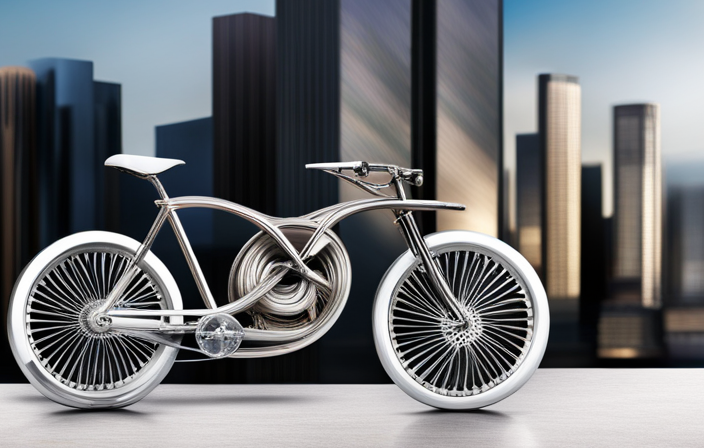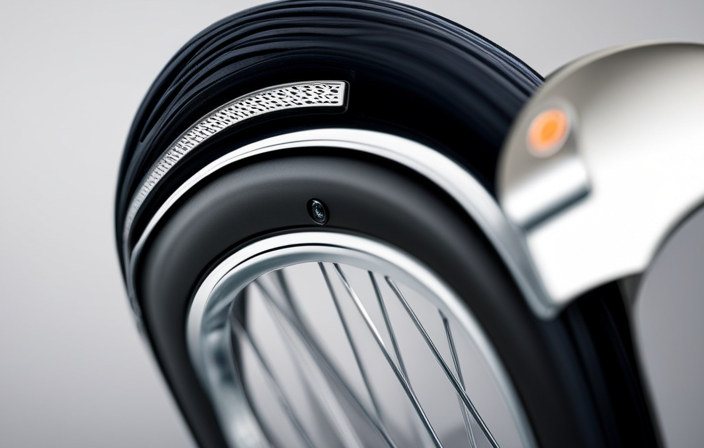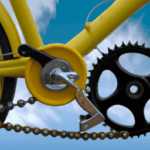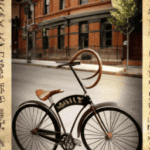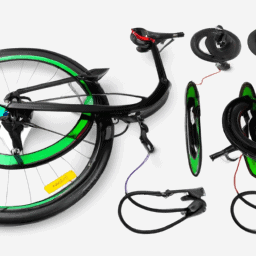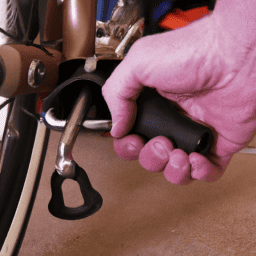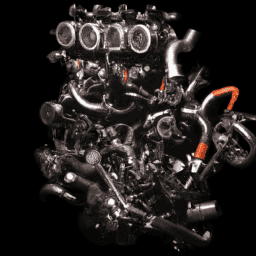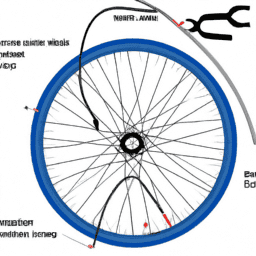Did you realize that the most costly bicycle in the world is priced at an astonishing $500,000? Yes, you heard that correctly, half a million dollars for a bicycle.
In this article, I will take you on a journey through the realm of luxury bicycles, showcasing some of the most extravagant and opulent designs ever created.
From the Aston Martin One-77 Limited Edition to the Bicygnals Luxury Bike, these bikes are not just modes of transportation, but works of art that redefine what it means to ride in style.
So buckle up, because we’re about to dive into the world of the most expensive bicycles ever made.
Key Takeaways
- Aston Martin One-77 Limited Edition Bicycle, Goldgenie Gold Bike Supreme, and Aurumania Crystal Edition Gold Bike are considered the most expensive bicycles in the world.
- These luxury bikes are known for their exquisite craftsmanship and luxurious design, often featuring collaborations with other brands or the use of unique materials.
- Trek Madone Butterfly Bike, KGS Bikes 1.0, and Montante Luxury Gold Collection Bike are high-performance bicycles with unique features and attention to detail, catering to collectors and those seeking extravagance.
- M55 Terminus, Vanhulsteijn Cyclone Bike, and Litespeed Blade are cutting-edge in terms of technology and design, offering lightweight construction and advanced components for superior performance and riding experience.
The Aston Martin One-77 Limited Edition Bicycle
If you’re looking for the most expensive bicycle in the world, you’ll definitely want to check out the Aston Martin One-77 Limited Edition Bicycle. This luxurious bike embodies the essence of high-end cycling with its limited edition design and exquisite craftsmanship.
Created in collaboration with Factor Bikes, this two-wheeled marvel features a lightweight carbon fiber frame that ensures optimal performance. The sleek and aerodynamic silhouette of the Aston Martin One-77 Limited Edition Bicycle is a testament to its premium quality.
Every detail, from the hand-stitched leather saddle to the precisely engineered components, showcases the meticulous attention to detail that Aston Martin is renowned for. This luxury bicycle is the epitome of elegance and sophistication, making it a must-have for any cycling enthusiast with a taste for the finer things in life.
Transitioning into the subsequent section about ‘the goldgenie gold bike supreme’, you’ll be amazed by the opulent design of yet another extraordinary bicycle.
The Goldgenie Gold Bike Supreme
You can’t help but admire the Goldgenie Gold Bike Supreme. This luxurious bicycle is not only a status symbol but also a masterpiece of craftsmanship. With its gleaming 24k gold-plated frame and components, it exudes opulence and elegance.
The customization options for the Goldgenie Gold Bike Supreme are truly remarkable. From choosing the color of the leather saddle to adding personalized engravings, every detail can be tailored to your taste. As the luxury bike market trends towards exclusivity and uniqueness, the demand for high-end bicycles like this one continues to soar. And it’s no wonder why.
Riding this golden beauty is like gliding on a cloud of indulgence.
Now, let’s move on to the aurumania crystal edition gold bike, a true marvel in its own right.
The Aurumania Crystal Edition Gold Bike
The Aurumania Crystal Edition Gold Bike is a stunning masterpiece featuring exquisite crystal details. Its design and craftsmanship are truly remarkable, making it a true work of art. The bike is meticulously handcrafted, with each crystal carefully placed to create a mesmerizing effect.
The combination of gold and crystal creates a luxurious and opulent look that is unmatched by any other bike in the world. The attention to detail is evident in every aspect of this bike, from the intricately designed frame to the sparkling crystals adorning the handlebars.
The Aurumania Crystal Edition Gold Bike is not only a beautiful piece of art, but it is also a high-performance bike. It boasts unique features and specifications that make it a top choice for avid cyclists.
Transitioning into the subsequent section about the Trek Madone Butterfly Bike, it is worth mentioning that this bike offers a completely different aesthetic and design, yet it is equally captivating in its own way.
The Trek Madone Butterfly Bike
Get ready to experience the beauty and elegance of the Trek Madone Butterfly Bike. It combines stunning design with top-notch performance. This masterpiece of engineering showcases an innovative design that sets it apart from any other bicycle on the market.
The Trek Madone Butterfly Bike features a unique butterfly motif, meticulously crafted into the frame and components. This creates a visually captivating masterpiece. The attention to detail is astounding, with every curve and line thoughtfully considered. It not only turns heads but also delivers exceptional performance with its lightweight construction and aerodynamic features. This bike is a true testament to the artistry and craftsmanship that goes into creating a high-end bicycle.
Transitioning seamlessly to the next section, let’s dive into the world of the KGS Bikes 1.0.
The KGS Bikes 1.0
Introducing the KGS Bikes 1.0, a revolutionary model that combines cutting-edge technology with exceptional performance. This bike is the epitome of luxury, boasting a range of features that will leave any cycling enthusiast in awe.
The KGS Bikes 1.0 is equipped with top-of-the-line components, including a lightweight carbon fiber frame that provides unmatched strength and agility. Its sleek design and aerodynamic shape ensure maximum speed and efficiency on the road. With a smooth-shifting electronic gear system and powerful disc brakes, this bike offers unrivaled performance advantages.
Whether you’re tackling steep climbs or cruising along flat terrain, the KGS Bikes 1.0 delivers superior handling and responsiveness.
Transitioning into the subsequent section, let’s explore the opulence of the montante luxury gold collection bike.
The Montante Luxury Gold Collection Bike
The KGS Bikes 1.0 was an impressive contender for the title of the most expensive bicycle in the world, but it has now been surpassed by the Montante Luxury Gold Collection Bike.
This exquisite masterpiece truly embodies luxury and opulence. The Montante Luxury Gold Collection bike is adorned with 24-karat gold leaf accents, making it a sight to behold.
Its design inspiration draws from the elegance and grandeur of Renaissance art, showcasing intricate details and craftsmanship. This bicycle is not just a mode of transportation; it is a statement of status and prestige.
The target market for this extraordinary creation is affluent individuals who appreciate the finest things in life and are willing to invest in exceptional luxury. The demand for such an exclusive item is undoubtedly high, as it appeals to collectors, cycling enthusiasts, and those who seek the epitome of extravagance.
Now, let’s move on to the next section and explore the remarkable M55 Terminus.
The M55 Terminus
You’ll be amazed by the M55 Terminus, a groundbreaking creation that pushes the boundaries of technology and design in the realm of luxury bikes. The design and features of the M55 Terminus are truly exceptional. This bike not only looks sleek and stylish, but it also incorporates cutting-edge technology that enhances its performance. The frame is made from lightweight carbon fiber, providing strength and durability. The electric motor allows for effortless riding, while the integrated battery ensures long-lasting power. With advanced suspension and high-quality components, the M55 Terminus offers a smooth and comfortable ride.
| Features | Technology | Design |
|---|---|---|
| Lightweight carbon fiber | Electric motor | Sleek and stylish |
| Advanced suspension | Integrated battery | High-quality components |
The M55 Terminus sets a new standard for luxury bikes, combining innovative technology with stunning design. It’s a true masterpiece that will leave any cycling enthusiast in awe. Now, let’s dive into the world of the Vanhulsteijn Cyclone Bike.
The Vanhulsteijn Cyclone Bike
Now let’s take a closer look at the Vanhulsteijn Cyclone Bike.
The design and craftsmanship of this bike is truly exceptional. Every curve and weld is meticulously crafted to create a sleek and elegant appearance.
The frame is made from high-quality steel, ensuring both durability and a smooth ride. The attention to detail is evident in every aspect, from the leather seat to the hand-painted finish.
But the Vanhulsteijn Cyclone Bike is not just a work of art, it is also a high-performance machine. With top-of-the-line components and advanced technology, this bike offers an exhilarating riding experience.
Whether you’re cruising through the city streets or tackling challenging terrains, the Cyclone Bike delivers unmatched performance.
And now, let’s shift gears and explore the incredible features of the Litespeed Blade.
The Litespeed Blade
Take a moment to imagine yourself riding the Litespeed Blade, experiencing its superior performance and cutting-edge features.
The Litespeed Blade is not just any ordinary bicycle; it is a masterpiece of engineering and innovation. With a rich history dating back to its inception in 1986, Litespeed has consistently pushed the boundaries of bicycle technology. The Blade, their flagship model, showcases their commitment to excellence.
Crafted from aerospace-grade titanium, this bike is not only incredibly lightweight but also incredibly strong. The seamless integration of advanced carbon fiber technology further enhances its performance. The result is a bike that delivers unparalleled speed, agility, and comfort. Riding the Litespeed Blade is like gliding through the wind effortlessly.
It’s no wonder that this extraordinary bike has become the epitome of luxury and performance in the cycling world.
Now, let’s delve into the world of the bicygnals luxury bike.
The Bicygnals Luxury Bike
Imagine yourself riding the Bicygnals Luxury Bike, enjoying its exclusive features and state-of-the-art design.
This bike is truly one of a kind, with unique features that set it apart from other high-end bicycles.
The Bicygnals Luxury Bike is equipped with an integrated LED lighting system, ensuring maximum visibility and safety during nighttime rides. Its carbon fiber frame not only provides strength and durability but also enhances its sleek and modern appearance.
The bike also features a wireless electronic shifting system, allowing for smooth and precise gear changes. When compared to other high-end bicycles, the Bicygnals Luxury Bike truly stands out with its attention to detail and cutting-edge technology.
It offers a superior riding experience that is unmatched by any other bike on the market.
Frequently Asked Questions
Can I purchase any of these expensive bicycles online?
Yes, you can purchase expensive bicycles online. Some pros include convenience and a wide selection. However, cons include not being able to test ride and potential shipping damages. Financing options are often available for online purchases.
How many units of each expensive bicycle model were produced?
Were the limited units of each expensive bicycle model intentional or due to constraints? How does the limited production affect the availability and exclusivity of these expensive bicycles? Limited production creates a sense of exclusivity, driving up market demand for these highly sought-after bicycles.
Are there any special features or technological advancements in these bicycles?
There are several performance benefits and material innovations found in the world’s most expensive bicycles. These include lightweight carbon fiber frames, aerodynamic designs, advanced suspension systems, and electronic shifting technology, all aimed at enhancing speed, comfort, and efficiency.
Do these expensive bicycles come with a warranty or guarantee?
These pricey bikes come with a lifetime warranty, ensuring peace of mind for the lucky owners. Maintenance requirements are minimal, with periodic tune-ups and regular cleaning. Exclusive events and clubs cater to the elite community of bicycle enthusiasts.
Are there any customization options available for these bicycles?
Yes, there are plenty of customization options available for these bicycles. From frame colors to components, you can create a bike that suits your style and preferences. Many of these options are available online.
Conclusion
After exploring the world of luxury bicycles, I am truly amazed by the incredible craftsmanship and innovation that goes into creating these masterpieces.
One interesting statistic that stood out to me is that the most expensive bicycle in the world, the Aston Martin One-77 Limited Edition Bicycle, costs a staggering $39,000.
This goes to show that for some, cycling is not just a means of transportation, but a symbol of luxury and status.
It is truly fascinating to see how the world of cycling has evolved to cater to the affluent and passionate individuals who value both style and performance.
